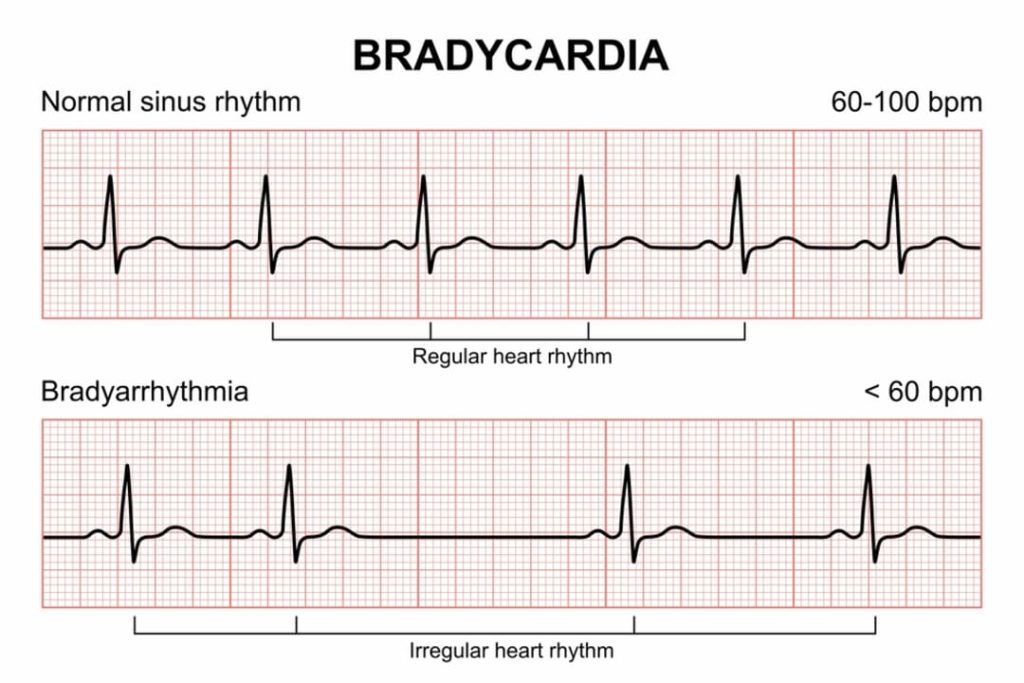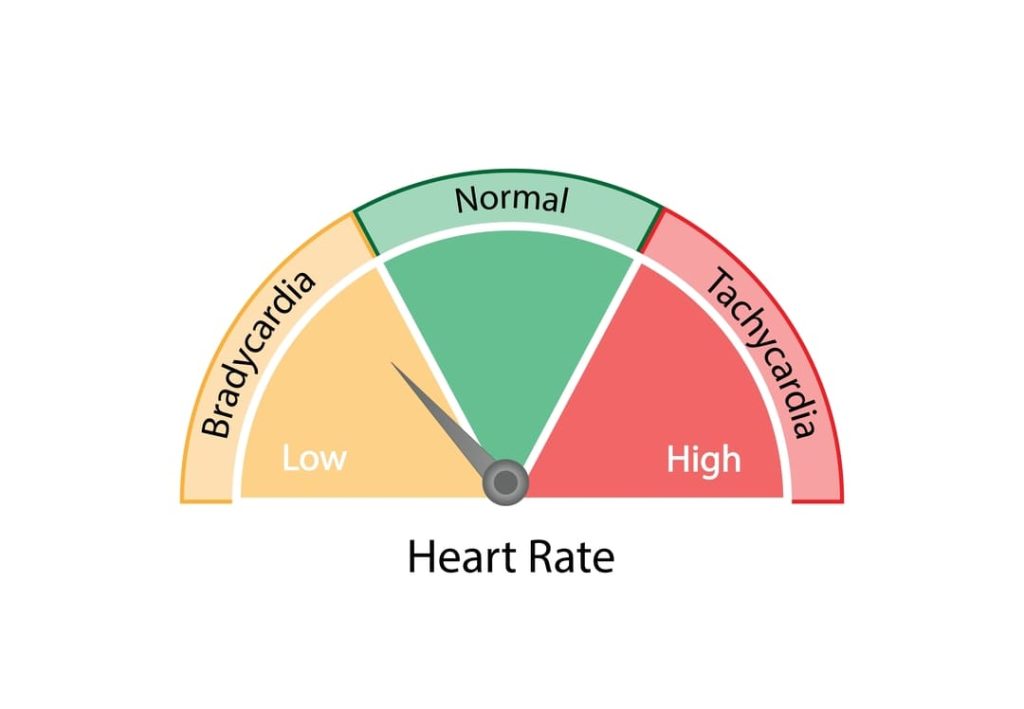Looking for Expert-Level VA Claim Answers?📱Call Us Now! 737-295-2226
This guide will cover how to qualify for a bradycardia VA disability rating, how the VA rates bradycardia, and much more.
You may qualify for a bradycardia VA disability rating if you can prove your military service caused your condition.
But how can you connect the two? We’ve covered everything you need to know about receiving the bradycardia VA rating you deserve.
Bradycardia, which results in a slower-than-normal heartbeat, is a ratable condition by the VA due to its effect on veterans.
Let’s get to it!
Table of Contents
Summary of Key Points
- Bradycardia is a heart condition where your heart beats slower than usual, generally less than 60 bpm (beats per minute).
- Eligible veterans may receive a temporary 100% VA rating for one month post hospital discharge, and then will follow the General Rating Formula for Diseases of the Heart.
- If symptoms are present, they may include chest pain, fatigue, and dizziness.

What is Bradycardia?
Bradycardia, or bradyarrhythmia, is a condition where your heart beats slower than usual, typically under 60 beats per minute. In an otherwise healthy person, bradycardia isn’t always problematic and shows little to no symptoms.
However, bradycardia becomes a problem if your heart is pumping too slowly to keep up with your body’s demand for oxygen.
There are five general classes of bradyarrhythmia:
- Sinus bradycardia, including sinoatrial block
- Atrioventricular (AV) junctional (nodal) escape rhythm
- AV heart block (second or third degree) or AV dissociation
- Atrial fibrillation or flutter with a slow ventricular response
- Idioventricular escape rhythm
If symptoms are present, they may include:
- Fatigue
- Chest pain
- Shortness of breath
- Heart palpitations
- Memory problems
- Lightheadedness
- Dizziness
Bradycardia treatment includes lifestyle changes, medication, and surgery, depending on the severity of your condition.

Bradycardia in Veterans
As a veteran, you may be susceptible to bradycardia due to PTSD (Post-traumatic stress disorder), disrupted sleep patterns, or stress directly linked to your military service.
While the PACT Act expanded benefits to such veterans, bradycardia isn’t considered a presumptive condition.
SEE MORE: What to Know if You Have an Abnormal Heart Rate
How the VA Rates Bradycardia
The VA rates bradycardia under diagnostic code (DC) 7009; however, it may also be rated under the general rating for heart diseases, depending on your specific symptoms.
The VA rates heart arrhythmia at 100% if you are symptomatic and require permanent pacemaker implantation.
You’ll receive a 100% VA disability rating for bradycardia the month post hospital discharge, and then will be re-evaluated based on the general rating formula for diseases of the heart.
After one month, bradycardia is evaluated under the general rating criteria for heart conditions, with VA ratings of 10%, 30%, 60% or 100%, depending on severity of symptoms.
Notes:
- Asymptomatic bradycardia (bradyarrhythmia) is a medical finding only and isn’t a ratable disability.
- There is no specific sinus bradycardia VA rating but it is evaluated under broader diagnostic codes related to heart conditions (see FAQ section).
Bradycardia VA Rating Chart
| DC 7009, Bradycardia | VA Rating |
| For one month following hospital discharge for implantation or re-implantation | 100% |
After one month, you’ll use the general rating formula for diseases of the heart as listed below.
| GENERAL RATING FORMULA FOR DISEASES OF THE HEART: | VA Rating |
| Workload of 3.0 METs or less results in heart failure symptoms | 100% |
| Workload of 3.1-5.0 METs results in heart failure symptoms | 60% |
| Workload of 5.1-7.0 METs results in heart failure symptoms; or evidence of cardiac hypertrophy or dilatation confirmed by echocardiogram or equivalent (e.g., multigated acquisition scan or magnetic resonance imaging) | 30% |
| Workload of 7.1-10.0 METs results in heart failure symptoms; or continuous medication required for control | 10% |
Note: If you disagree with the bradycardia VA rating the VA assigns, you have the right to appeal for an increased rating.
RELATED: What is the Tachycardia VA Rating?
How to Get VA Disability for Bradycardia
To receive a VA disability rating, you must service-connect your condition.
Service-connecting your bradycardia proves to the VA that your military service caused or aggravated your condition. This also means that if you had the condition before you entered the service, you could still qualify for VA disability benefits.
To prove service connection, you must provide the following information:
- A current medical diagnosis of bradycardia
- Evidence of an in-service event, injury or illness that caused or aggravated your condition
- A medical nexus (or link) connecting your medical condition to your military service
Your final VA rating for bradycardia will depend on the severity of your symptoms and the effect they have on the quality of your life.
RELATED: VA Disability for Heart Conditions
Filing a VA Claim for Bradycardia
Once you have your medical diagnosis of bradycardia, you can begin the process of filing a VA claim.
The easiest way to file a VA claim is online, but we understand that’s not always the best option for everyone.
You can also print VA Form 21-526EZ and file a VA claim in one of the following ways:
- Mail to:
Department of Veterans Affairs
Claims Intake Center
PO Box 4444
Janesville, WI 53547-4444
- In person at your local regional VA office
- By fax to:
844-531-7818 (Inside the U.S.)
248-524-4260 (Outside the U.S.)
CHECK THE STATUS OF YOUR VA CLAIM

Related Guides
VA Disability for Heart Conditions
VA C&P Exam for Heart Conditions
How to Get a VA Disability Rating for Hypertension
What is the Tachycardia VA Rating?
NEED MORE ASSISTANCE?
Most veterans are underrated for their disabilities and, therefore, not getting the compensation they’re due. At VA Claims Insider, we educate you on how to understand and take control of the claims process so you can get the rating and compensation you’re owed by law.
Our process takes the guesswork out of filing a VA disability claim and supports you every step of the way in building a fully developed claim (FDC)—so you can increase your rating fast! If you’ve filed your VA disability claim and have been denied or have received a low rating—or you’re unsure how to get started—reach out to us!
Take advantage of a VA Claim Discovery Call. Learn what you’ve been missing—so you can FINALLY get the disability rating and compensation you deserve!
FAQs
Is bradycardia a presumptive condition?
No, bradycardia isn’t considered a presumptive condition. However, you still may qualify for VA disability benefits if you can prove your military service caused your condition.
What is the bradycardia VA disability rating?
If eligible, you’ll receive a temporary 100% bradycardia VA rating for one month post hospital discharge. Following that month, you’ll receive a 10%, 30%, 60%, or 100% VA rating based on the general rating formula for diseases of the heart.
Is there a sinus bradycardia VA rating?
There is no specific sinus bradycardia VA rating, but it is evaluated under broader diagnostic codes related to heart conditions. The possible VA ratings depend on the severity of symptoms and their impact on your daily life. Here’s how it might be rated:
Diagnostic Code 7010 – Supraventricular Arrhythmias: 0%: This rating might be given if the bradycardia is asymptomatic or doesn’t significantly affect your health.
10%: If the bradycardia causes occasional symptoms or requires medication, a 10% rating might be appropriate.
30%: This rating might be applied if there are frequent symptoms and more significant functional limitations.
60%: If the condition results in severe symptoms or frequent episodes that affect daily functioning, a higher rating like 60% could be assigned.
Diagnostic Code 7007 – Hypertensive Heart Disease: 10%: If the sinus bradycardia is associated with mild symptoms or requires occasional medication.
30%: If there are moderate symptoms, frequent treatment, or some functional limitations.
60%: For severe symptoms, frequent episodes, or significant impact on daily life.
100%: For the most severe cases with constant symptoms, substantial impact on health, or if it results in chronic heart failure.
Your specific VA rating depends on your symptoms’ frequency, duration, and severity.
What evidence should I include with my VA claim for bradycardia?
While not required, medical evidence frequently proves to be the missing link between being denied and winning your VA claim. Examples of evidence to include with your VA claim for bradycardia include: medical and hospital records, personal and lay statements, and medical nexus letters.
Author

Kelly Olone
Kelly Olone is a military spouse who earned her degree in Psychology from Florida International University. After working in the non-profit sector for several years, she turned to her passion for writing. She aims to contribute to a better understanding of the valuable benefits that veterans deserve. As a mom, Kelly navigates the delicate balance between deadlines and bedtime stories with finesse.



